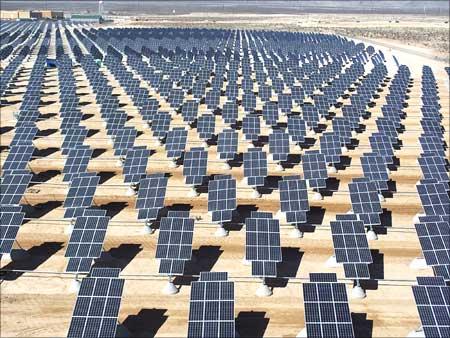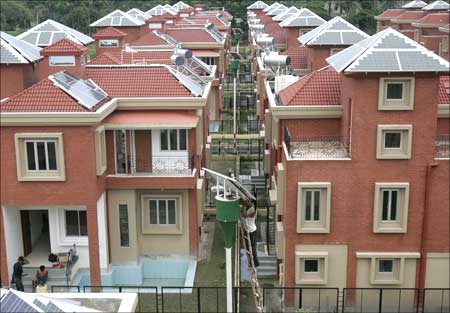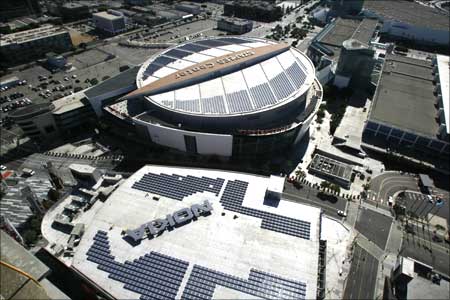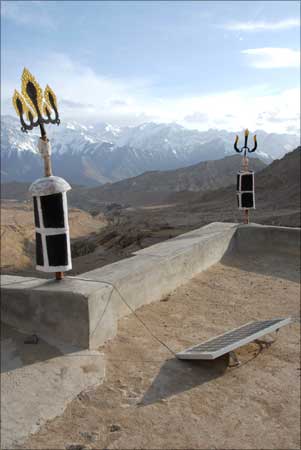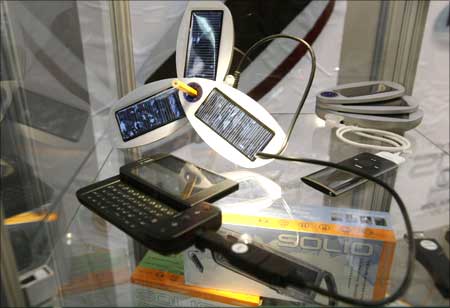 | « Back to article | Print this article |
India's ambitious solar power plans
India's Rs 4,800-crore (Rs 48 billion) solar power industry, which exports around 60 to 70 per cent of its wares to Europe, North America and China, seems to have taken a cue from the IT sector and is aiming for a greater foothold in the Indian market.
India, where most regions enjoy nearly 300 sunny days a year, is an ideal market for solar power companies. However, the high cost of light-to-electricity conversion - at Rs 12 to Rs 20 per kWh (kilowatt-hour) - has acted as a deterrent so far, according to Frost & Sullivan Deputy Director (Energy and Power Systems) Amol Kotwal.
Currently, India has around 60 companies assembling and supplying solar photovoltaic systems, nine companies manufacturing solar cells and 19 companies manufacturing photovoltaic modules or panels, according to an Indian Semiconductor Association study.
However, spurred by factors like an increased demand for clean power, an energy-starved industry and the falling cost of solar-power generation, companies in this space are coming up with a noteworthy number of domestic projects. It has also helped that the government is lending support to such projects through state electricity boards with subsidies.
India's ambitious solar power plans
The Centre has recently approved 12 proposals under the Special Incentives Package Scheme. Put together, these proposals could bring in about Rs 76,573 crore (Rs 765.73 billion) of investment to the domestic solar power sector.
Under SIPS, the government provides an incentive of 20 per cent of the capital expenditure during the first 10 years to a unit located in a special economic zone. Units based outside get a 25 per cent incentive. Incentives could be in the form of capital subsidy or equity participation.
Players and projects
Proposals in this space have been submitted by Solar Semiconductor (Rs 11,821 crore or Rs 118.21 billion), Reliance Industries (Rs 11,631 crore or Rs 116.31 billion), Moser Baer PV Technologies (Rs 6,000 crore or Rs 60 billion), Signet Solar (Rs 9,672 crore or Rs 96.72 billion), Titan Energy Systems (Rs 5,880 crore or Rs 58.80), KSK Energy Ventures (Rs 3,211 crore or Rs 32.11 billion) and Tata BP Solar India (Rs 1,693 crore or Rs 16.93 billion).
Besides this, the government has received similar applications from companies such as EPV Solar, Vavasi Telegence and Lanco Solar, according to industry sources.
India's ambitious solar power plans
Clearly, the solar power sector is seeing heightened activity. Tata BP Solar - which has been designing, manufacturing and installing solar solutions for the past 15 years - is "investing significantly in infrastructure to expand its manufacturing capacity to 300 MW," says K Subramanya, the company's chief executive officer.
Revenues for Tata BP Solar exceeded Rs 1,100 crore (Rs 11 billion) in 2008-09. The company - a 51:49 joint venture between BP Solar and Tata Power Company - is looking to expand into rural areas by partnering with banking and telecom companies.
Consider this. Three years ago, Aryavart Gramin Bank, a regional rural bank based in Uttar Pradesh, realised that it needed uninterrupted power supply to run its computers in rural areas. The bank replaced fuel-guzzling diesel generators installed at five of its branches with photovoltaic systems.
The bank, impressed by the ease and reliability of solar power, soon launched finance schemes that helped over 8,000 rural households procure Tata BP Solar's solar home lighting systems.
India's ambitious solar power plans
The company is also catering to the requirements of the railways and defence sectors - two of the largest consumers of solar power in India.
For instance, it has installed India's largest Building Integrated Photovoltaics at the Samudra Institute of Maritime Studies in Lonavla, Pune. The 90-KWp (kilowatt-peak) BIPV can meet the entire power requirement of the institute.
Other notable projects executed by Tata BP Solar include a 100-KWp system installed to supplement the power requirement of Vikas Soudha - a replica of Vidhana Soudha - in Bangalore and a 10,000-litre capacity solar water heater system at the Tirupati temple complex.
"Solar water heaters for industrial applications, in particular, are extremely attractive since they have a payback period of two to three years," explains Subramanya.
Similarly, Moser Baer Photovoltaic CEO Rajiv Arya is gung-ho that his division can grow into "an over $1-billion (Rs 4,780 crore) unit producing supplies worth one gigawatt capacity by the end of calendar year 2010."
The company's current supplied capacity is 120 MW (megawatt). This will go up to 300 MW by the end of 2009 across different technology verticals, say company sources.
India's ambitious solar power plans
Moser Baer's strategy is to manufacture small appliances, ranging from one to 10 KW in capacity. These include solar lanterns which have found use in villages, solar lights that illuminate Jaipur's highways and Gurgaon's DLF malls, and solar energy appliances that would power ATM machines in rural areas in the near future.
At present, Moser Baer is focusing on two grid-connected solar farms - one in Rajasthan and the other in Punjab - each with 5-MW capacity. "It takes about three to six months to obtain land and start the project. These farms will produce power of 1 MW in five phases taking the total to 5 MW," says Arya.
PSU ventures
There are other cases in point. Bharat Heavy Electricals Limited recently commissioned two grid-interactive solar power plants of 100 KWp each in Lakshadweep. This is the largest solar power project of its kind in the country which aims to use solar energy to power an entire region.
So far, BHEL has commissioned a total of 11 solar power plants in the Lakshadweep islands, adding over 1 MW of solar power to the power-generating capacity of the coral islands. The plants have been set up at Chetlat and Amini islands of Lakshadweep.
BHEL's solar power plants cater to about 15 per cent of the Union Territory's energy demand.
India's ambitious solar power plans
With the installation of solar power plants, Lakshwadeep will save 300,000 litre of diesel a year - huge savings given that diesel is transported by sea from Kochi, which is a costly affair. The solar power plants, as opposed to environmentally hazardous diesel generators, will be conducive to the fragile ecology of the coral islands.
Starting from small applications like solar-powered street lights, rural water pumping systems, railway signaling and offshore drilling platforms, BHEL has commissioned and installed large-size standalone as well as grid-interactive solar power plants in a number of major cities and remote areas of the country. The solar cells and modules manufactured here are also exported to various countries like Germany, Australia and Italy.
Public sector major Oil and Natural Gas Commission, too, is foraying into solar energy. It is in talks with four players to set up photovoltaic cells unit in the country, ONGC chairman R S Sharma has told this paper.
Railways, telecom, military agencies and space organisations remain the largest consumers of photovoltaic systems in India.
But there's much catching up to do with developed countries where grid connectivity accounts for about 75 per cent of the installed capacity and off-grid lighting and consumer applications for the rest of solar power production.
